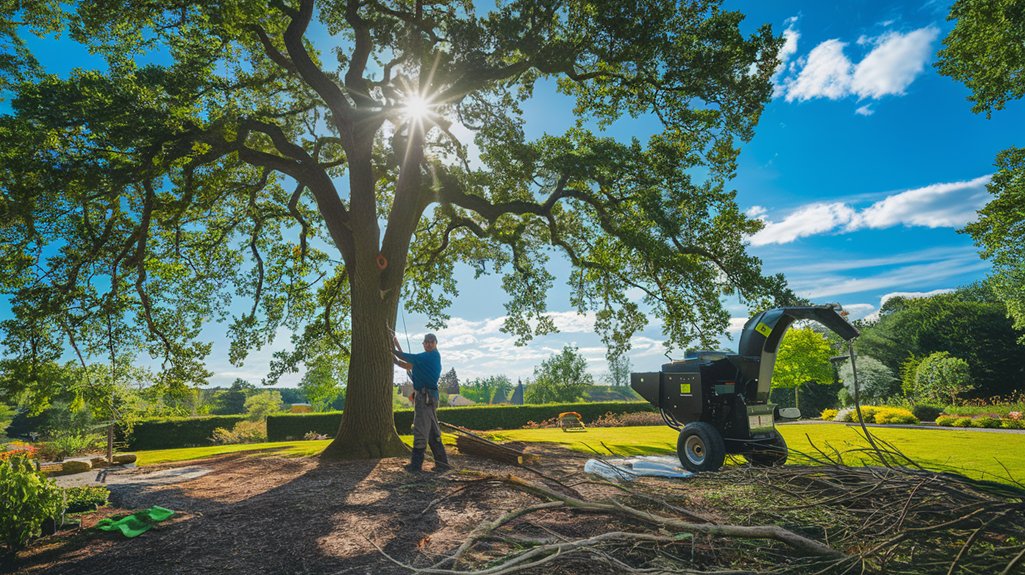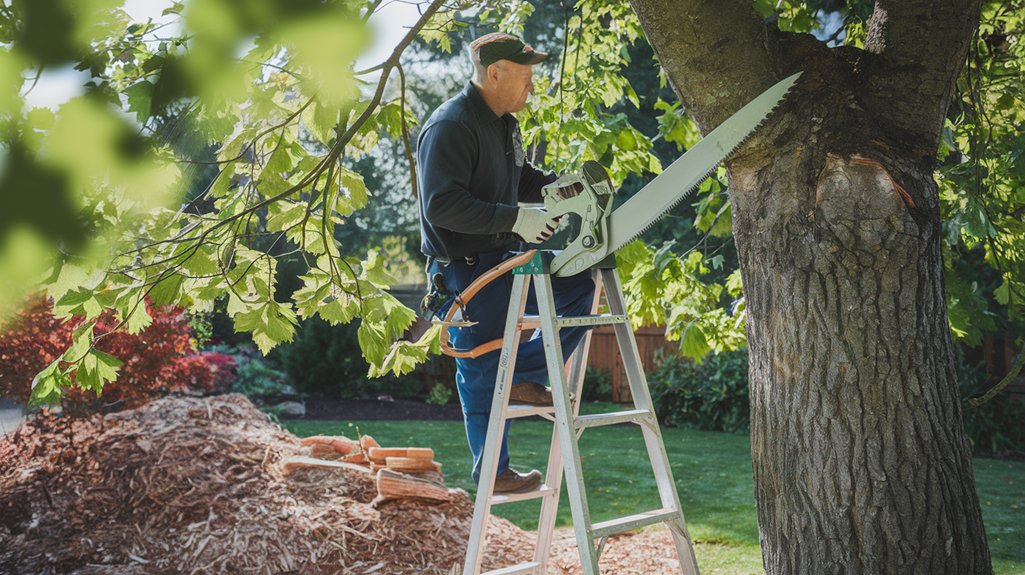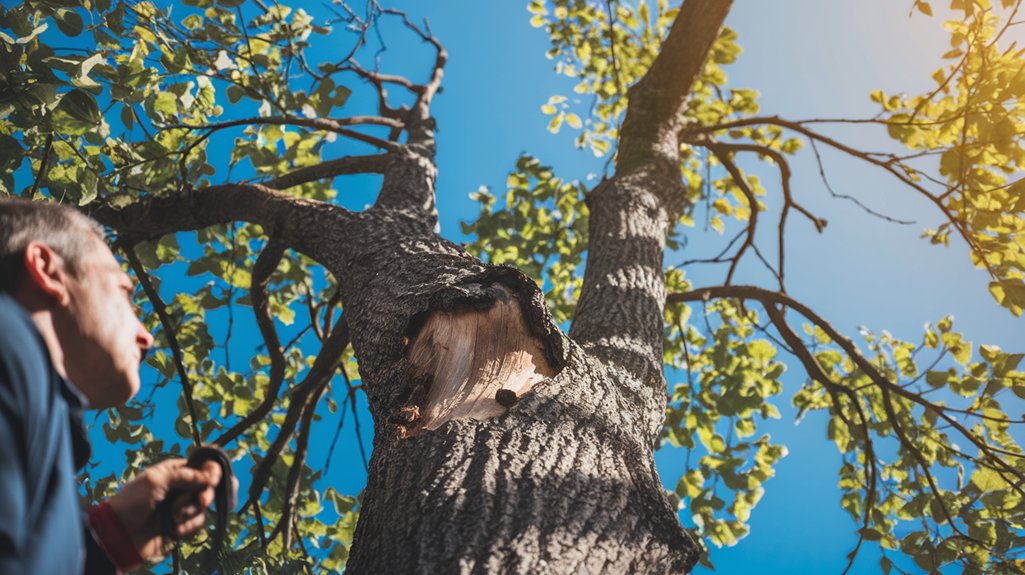Tree care is crucial for maintaining not just the health of individual trees, but also the overall landscape and ecosystem. You might be wondering how to properly prune your trees or when it’s time to consider removal. Understanding these practices can significantly enhance your outdoor space and improve air quality. Let’s explore the essential techniques and knowledge you need to ensure your trees thrive for years to come.
Understanding the Importance of Tree Care

Trees are vital to our environment, providing shade, beauty, and oxygen. You mightn’t realize how important tree health is for maintaining these benefits.
Healthy trees contribute to cleaner air by absorbing carbon dioxide and releasing oxygen, which enhances your surroundings. They also support local wildlife, offering habitats for birds and insects.
By understanding tree care, you can ensure these environmental benefits continue for generations. Regular maintenance, like checking for diseases and pests, helps trees thrive and prevents potential hazards.
When you invest time in your trees, you’re not just improving your property; you’re also contributing to a healthier ecosystem.
A Tree Care Guide ensures these benefits. Learn more from Colorado State University Extension.
The Art of Pruning: Techniques and Timing

When it comes to maintaining healthy trees, mastering the art of pruning is essential for encouraging growth and preventing problems.
You’ll want to familiarize yourself with various pruning techniques, such as crown thinning, which improves light penetration, and deadwood removal, which enhances safety and tree health.
Timing is crucial; most trees benefit from pruning during their dormant season, typically late winter or early spring. This minimizes stress and encourages robust growth as the tree wakes up.
Always use sharp, clean tools to make precise cuts, which helps the tree heal faster.
By understanding these techniques and seasonal timing, you’ll ensure your trees thrive and remain beautiful for years to come.
Happy pruning!
When to Remove a Tree: Signs and Considerations

Understanding pruning techniques helps you keep trees healthy, but sometimes removal is the best option for safety and aesthetics.
Look for signs of tree health decline, such as significant leaf loss or dead branches. If you notice disease signs like fungal growth or decay, it might be time to consider removal.
Additionally, assess any safety risks; trees close to structures can pose threats if they’re unstable. Root issues can cause property damage or weaken the tree’s foundation.
Finally, think about the landscape impact—a tree that overshadows your garden or obstructs views might need to go. Evaluating these factors will help you make a responsible decision about whether to remove a tree for the greater good of your property.
Essential Tools for Tree Maintenance
Maintaining your trees requires the right tools to ensure their health and longevity. Investing in quality maintenance equipment is essential for effective tree pruning and care. Here’s a quick overview of the must-have tools:
| Tool | Purpose | Tips for Use |
|---|---|---|
| Pruning Shears | Trim small branches | Keep blades sharp |
| Loppers | Cut larger branches | Use for up to 2-inch cuts |
| Chainsaw | Remove large limbs | Follow safety guidelines |
| Rake | Clear debris | Use after pruning sessions |
| Safety Gear | Protect yourself | Always wear gloves and goggles |
With these essential tools, you’ll be well-equipped to maintain your trees effectively, ensuring they thrive for years to come.
Ongoing Tree Care: Best Practices for Longevity
To ensure your trees thrive for many years, it’s crucial to adopt ongoing care practices that promote their health and resilience.
Here are some best practices you should follow:
- Seasonal Pruning: Regularly trim your trees to encourage healthy growth and remove any dead or diseased branches.
- Mulching: Apply organic mulch around the base to retain moisture and improve soil health while suppressing weeds.
- Watering: Ensure your trees receive adequate water, especially during dry spells, to support their overall health.
- Soil Testing: Conduct periodic soil tests to assess nutrient levels and make necessary amendments for optimal growth.
Hiring a Professional: What to Look For
When you’re considering tree care, hiring a professional can make a significant difference in the health and appearance of your trees.
Start with a qualifications assessment to ensure the arborist has the proper certifications and training. Look for someone who understands local tree species and their specific needs.
Next, check service reviews to gauge the experiences of previous clients. Positive feedback can indicate reliability and quality work. Don’t hesitate to ask for references or examples of past projects.
Finally, ensure they offer a comprehensive approach, including pruning, removal, and ongoing maintenance.
Frequently Asked Questions
How Do Weather Conditions Affect Tree Health and Maintenance?
Weather conditions significantly impact tree health. During drought, trees struggle to access water, leading to stress. Conversely, storms can cause severe damage, breaking branches or uprooting trees. You must monitor both to ensure proper maintenance.
Can Trees Recover From Severe Pruning or Damage?
Yes, trees can recover from severe pruning or damage. You’ll find that utilizing recovery techniques, such as proper watering and mulching, enhances tree resilience, allowing them to bounce back and thrive over time.
What Are the Benefits of Mulching Around Trees?
Mulching around trees offers several benefits. It improves moisture retention, reduces weed competition, and regulates soil temperature, helping your trees thrive. You’ll notice healthier growth and reduced stress on the tree during dry periods.
How Do Tree Diseases Spread and How Can They Be Prevented?
Tree diseases spread through soil, water, and insects, making disease transmission a concern. To prevent them, you should implement prevention methods like proper watering, pruning, and maintaining healthy soil to keep your trees thriving.
What Regulations Exist for Tree Care in Urban Areas?
In urban areas, you need to understand local tree regulations and compliance requirements. These rules often dictate tree maintenance practices, species selection, and removal procedures to ensure safety, aesthetics, and environmental benefits for the community.
In conclusion, mastering tree care is vital for enhancing your landscape and supporting the environment. By understanding pruning techniques, recognizing when to remove a tree, and committing to ongoing maintenance, you can keep your trees healthy and thriving. Don’t hesitate to seek professional help if needed; it can make all the difference. With these practices in mind, you’re well on your way to becoming a skilled steward of your trees and the ecosystems they support.
Contact Us
Follow this Tree Care Guide with Above & Beyond Services for thriving Denver trees. Call (720) 806-6378 or visit Above & Beyond Services for free quotes on tree care, pest control, and more.
Key Takeaways
- Regular pruning during the dormant season promotes healthy growth and prevents tree diseases by removing deadwood and enhancing light penetration.
- Recognize signs for tree removal, such as significant leaf loss, decay, or structural instability, to ensure safety and landscape health.
- Essential tools include pruning shears, loppers, chainsaws, and safety gear to effectively maintain trees and prevent injuries.
- Ongoing care practices like mulching, adequate watering, and periodic soil testing support tree health and longevity in any environment.
- Investing time in tree care enhances air quality, supports wildlife, and contributes to a healthier ecosystem overall.




